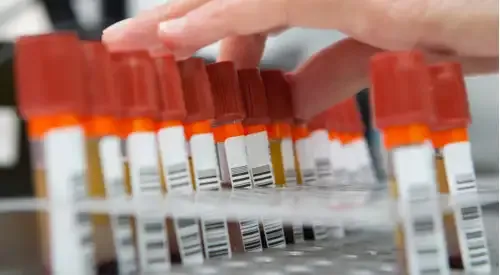Alpha-1-antitrypsin deficit
"Currently, gene therapy clinical trials are being conducted that attempt to correct the genetic defect responsible for AAT deficiency by introducing the correct gene into liver cells, but the results are not yet known".
DR. DELIA D'AVOLA
SPECIALIST. HEPATOLOGY UNIT

Alpha-1-antitrypsin deficiency is a genetic disease characterized by low levels of a substance called Alpha-1-antitrypsin (AAT), which is essential for balancing/contrasting protease activity.
AAT deficiency occurs in 1/2,500 individuals in Europe and is more frequent in Scandinavian countries. It is due to mutations in the SERPINA1 gene which is transmitted in an autosomal recessive manner. As a consequence of this genetic defect, a non-functional altered form of AAT is produced, which accumulates in the liver, producing the progressive destruction of liver cells and the establishment of liver cirrhosis.
In the lung, AAT deficiency leads to the uncontrolled activity of other proteins that are activated during states of inflammation in response to various types of damage (infections, irritants such as tobacco smoke). This results in the progressive destruction of the walls of the alveoli (small sacs located at the end of the airways) which in the long term causes pulmonary emphysema.

What are the symptoms of high-1-antitrypsin deficit?
The symptoms of AAT deficiency depend on the type of genetic defect inherited.
Dyspnea (shortness of breath) is usually the first symptom and appears between 30 and 45 years of age.
Dyspnea can be accompanied by coughing and breathing sounds similar to those produced in asthma and increased susceptibility to respiratory infections.
Also at diagnosis there may be signs of liver involvement of various levels up to cirrhosis.
The most common symptoms are:
- Dyspnea (shortness of breath).
- Cough.
- Breathing sounds.
- Liver failure.
Do you have any of these symptoms?
You may have a deficit of alpha-1-antitrypsin
How is alpha-1-antitrypsin deficiency diagnosed?

Alpha-1-antitrypsin (AAT) deficiency is typically diagnosed by low blood levels of AAT. In patients with high suspected AAT deficit and doubtful AAT levels, it is possible to study the variants of AAT in peripheral blood (phenotype).
Radiological explorations such as chest X-ray and pulmonary CT can target the presence of pulmonary emphysema of varying severity. To assess the degree of respiratory dysfunction it is useful to perform respiratory function tests.
Liver involvement and the presence of complications can be studied with ultrasound, CT and/or MRI of the liver.
How is alpha-1-antitrypsin deficiency treated?
Patients diagnosed with AAT deficiency should minimize exposure to infectious agents and respiratory tract irritants (smoking cessation, flu vaccination, and the major agents responsible for pneumonia).
The use of bronchodilators and oxygen therapy is indicated when airflow is obstructed or hypoxemia (low blood oxygen levels) is present.
Intravenous administration of AAT has been possible for some years and may be useful in patients with pulmonary involvement documented by respiratory function tests.
While AAT treatment may improve respiratory function in patients where it is involved, this treatment has no effect on liver disease and the only treatment for advanced liver disease is liver transplantation.
Where do we treat it?
IN NAVARRE AND MADRID
The Department of Pneumology
of the Clínica Universidad de Navarra
Specializing in smoking and tobacco-related diseases, the Department has over 15 years of experience in smoking cessation and lung cancer early detection programs.
The department's specialists have received training at leading centers around the world, including centers in the United States, and have extensive experience in the diagnosis and treatment of all respiratory diseases, both common and rare.
Diseases we treat
|

Why at the Clínica?
- Leading clinical assistance with great work in research and teaching.
- Specialized nursing team.
- We work together with the Sleep Unit and the Lung Cancer Area.







